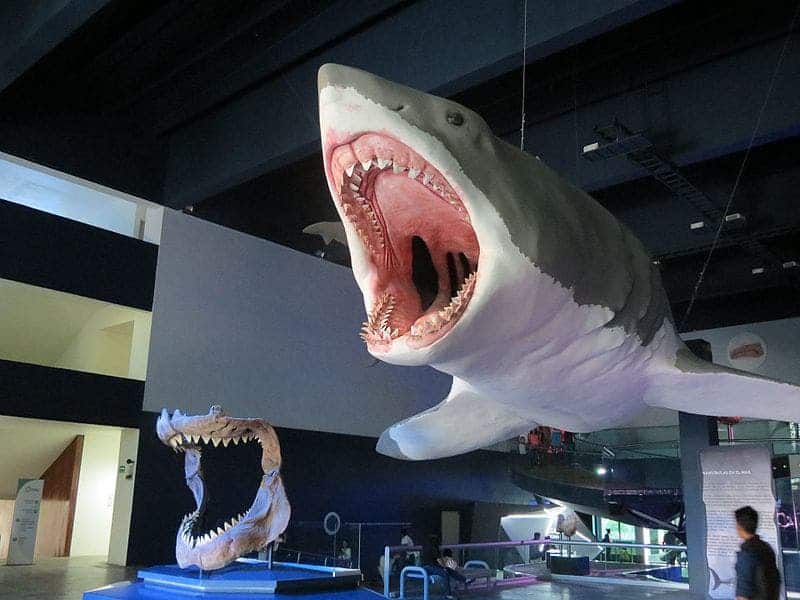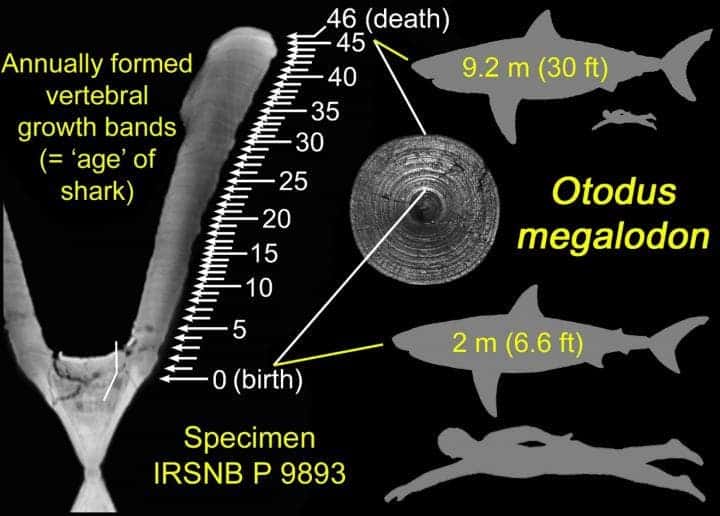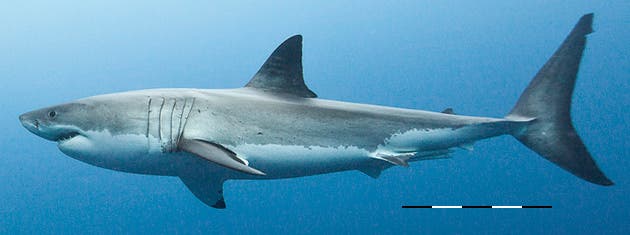
Perhaps the fiercest shark that ever swam the world’s oceans was Otodus megalodon, an extinct species of shark that lived from the early Miocene to the end of the Pliocene, from 23 to 2.6 million years ago.
Megalodon was the uncontested marine predator of ancient times, reaching 15 meters (50 feet) in length — twice as long as the second-largest shark in history. Not surprisingly, Megalodon’s babies were also on the hefty side. According to a new study, Megalodon newborns were larger than most adult humans.
The study led by Kenshu Shimada—a professor of paleobiology at DePaul University in Chicago and research associate at the Sternberg Museum in Kansas—is one of the first that examined growth bands in Megalodon specimens.
Like all sharks, Megalodon’s skeleton was mostly made of cartilage. This means that only its teeth and vertebrae have survived in the fossil record. But these seemingly limited fossils can reveal a wealth of information about the intimate lives of ancient sharks, and even how they breed.
Megalodon’s vertebrae grow in incremental, distinct layers, analogous to tree rings. Each layer or growth band reveals information about the animal’s characteristics, such as its girth and body size at the time of deposition.

Shimada and colleagues, who included Matthew Bonnan of Stockton University, New Jersey, and Martin Becker and Michael Griffiths of William Paterson University, New Jersey, used CT scanning techniques to examine the growth bands of a 9-meter Megalodon fossil.
The fossil’s 46 growth bands mean the shark died at age 46. By analyzing how each band formed in the giant vertebrae, the researchers could calculate the shark’s body length during each year of its life, including at its birth.
“Because no one has examined ‘growth bands’ in Megalodon vertebrae using a CT scanner in the past, I was not sure if the approach would work. The detection of the very fine growth bands is literally the breakthrough of this study,” Shimada told ZME Science.
This back-calculation suggests that Megalodon gave live birth to the largest babies in the shark world, measuring about 2 meters (6.6 feet) in length. But that’s not the study’s most interesting conclusion.
Researchers also revealed how Megalodon’s embryos developed, how it gave birth, and even provided one of the most accurate estimates of Megalodon’s lifespan.
Like modern Lamniforms, one of the most well-known groups as it includes famous species and feared hunters, like the Great White Shark, Basking Shark, and Mako (Shortfin and Longfin), Megalodon also gave birth to live young. And like modern sharks, these baby Megalodons were killers well before they left their mum’s womb.
“Lamniform sharks don’t lay their eggs outside of the body, but instead eggs hatch inside the mother that eventually gives live birth to young pups. A very interesting fact is that ‘early-hatched embryos’ will begin to eat surrounding unhatched eggs and at least in sandtiger sharks occasionally even feed on other hatched siblings for nourishment,” Shimada told ZME Science.
“The consequence is that only a few pups will survive and develop, but each of them can become considerably large in body size at birth. Although energetically costly for the mother to raise such large embryos, neonates have an advantage as ‘already-large’ predators with reduced chances of getting eaten by other predators.”
Concerning Megalodon’s lifespan, the researchers found that the ancient predator grew at a rate of about 16 centimeters (6.3 inches) per year or at least for the first 46 years of its life based on the only sample the researchers studied thus far. According to a growth curve model based on the vertebrae growth bands, the researchers estimate that Megalodon had a life expectancy between 88 and 100 years. These estimates, however, may change dramatically as the researchers analyze more Megalodon fossils.
“While the new study has given us a pretty good idea about the growth pattern between birth and ‘middle-age’ for Megalodon, the exact growth pattern past 46 years old, including its inferred life expectancy of at least 88-100 years, remains rather theoretical and needs further investigation,” Shimada said.
The findings were reported in the journal Historical Biology.






